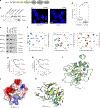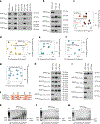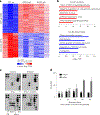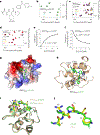Molecular basis for nuclear accumulation and targeting of the inhibitor of apoptosis BIRC2
- PMID: 37524969
- PMCID: PMC10702411
- DOI: 10.1038/s41594-023-01044-1
Molecular basis for nuclear accumulation and targeting of the inhibitor of apoptosis BIRC2
Abstract
The inhibitor of apoptosis protein BIRC2 regulates fundamental cell death and survival signaling pathways. Here we show that BIRC2 accumulates in the nucleus via binding of its second and third BIR domains, BIRC2BIR2 and BIRC2BIR3, to the histone H3 tail and report the structure of the BIRC2BIR3-H3 complex. RNA-seq analysis reveals that the genes involved in interferon and defense response signaling and cell-cycle regulation are most affected by depletion of BIRC2. Overexpression of BIRC2 delays DNA damage repair and recovery of the cell-cycle progression. We describe the structural mechanism for targeting of BIRC2BIR3 by a potent but biochemically uncharacterized small molecule inhibitor LCL161 and demonstrate that LCL161 disrupts the association of endogenous BIRC2 with H3 and stimulates cell death in cancer cells. We further show that LCL161 mediates degradation of BIRC2 in human immunodeficiency virus type 1-infected human CD4+ T cells. Our findings provide mechanistic insights into the nuclear accumulation of and blocking BIRC2.
© 2023. The Author(s), under exclusive licence to Springer Nature America, Inc.
Conflict of interest statement
Competing interests
The authors declare no competing interests.
Figures






References
-
- Gyrd-Hansen M & Meier P IAPs: from caspase inhibitors to modulators of NF-kappaB, inflammation and cancer. Nat. Rev. Cancer 10, 561–574 (2010). - PubMed
-
- Estornes Y & Bertrand MJ IAPs, regulators of innate immunity and inflammation. Semin. Cell Dev. Biol. 39, 106–114 (2015). - PubMed
-
- Wang X, Ragupathy V, Zhao J & Hewlett I Molecules from apoptotic pathways modulate HIV-1 replication in Jurkat cells. Biochem. Biophys. Res. Commun. 414, 20–24 (2011). - PubMed
Publication types
MeSH terms
Substances
Grants and funding
- R01 GM125195/GM/NIGMS NIH HHS/United States
- R01 CA268440/CA/NCI NIH HHS/United States
- R01 MH128021/MH/NIMH NIH HHS/United States
- UM1 AI068616/AI/NIAID NIH HHS/United States
- R01 NS104015/NS/NINDS NIH HHS/United States
- R01 CA204020/CA/NCI NIH HHS/United States
- R01 HL151334/HL/NHLBI NIH HHS/United States
- R01 AG067664/AG/NIA NIH HHS/United States
- UM1 AI106716/AI/NIAID NIH HHS/United States
- R56 AG067664/AG/NIA NIH HHS/United States
- R01 CA252707/CA/NCI NIH HHS/United States
- R01 CA255506/CA/NCI NIH HHS/United States
- R01 GM135671/GM/NIGMS NIH HHS/United States
- UM1 AI068632/AI/NIAID NIH HHS/United States
LinkOut - more resources
Full Text Sources
Molecular Biology Databases
Research Materials
Miscellaneous

